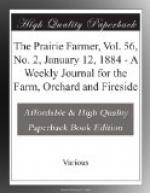Lung Disease in Swine.—A.J.T., Emery, Ill. Most internal diseases of swine, especially inflammation of the lungs, which is often given the wrong name of thumps, are very intractable and apt to prove fatal when occurring during the winter months. Prevention is the sheet anchor for these troubles, and it must be a poor farmer indeed who can not manage to provide clean, comfortable and dry housing for his live stock during this season, or who can not comprehend that such is necessary for the well-doing of animals as well as of himself. Any animal, even a hog, will of course suffer more, or less severely when constantly exposed to chilly winds, draft of cold air, wet ground and damp surroundings, icy or frozen drink or food, etc.
Blindness After Lockjaw.—M.J.G., Los Angeles, Cal. Let the animal go loose in a comfortable, roomy, well-bedded shed, from which strong light is excluded. Apply, once daily, to the hollow space above the orbit of the eyes, a small portion of fluid extract of belladonna. Give food which does not require much hard chewing.
* * * * *
REMEMBER that $2.00 pays for THE PRAIRIE FARMER one year, and the subscriber gets a copy of THE PRAIRIE FARMER COUNTY MAP OF THE UNITED STATES, FREE! This is the most liberal offer ever made by any first-class weekly agricultural paper in this country.
HORTICULTURAL
[Illustration]
Horticulturists, Write for Your Paper.
THE HEDGE QUESTION.
At one of the December meetings of the Massachusetts Horticultural Society a prize essay from the pen of John J. Thomas, of Union Springs, N.Y., was read on the subject “Hedge Plants and Hedges.”
The subject of the essay was proposed in the form of a question, “Are live hedges to be recommended either for utility or ornament, and if they are, what plants are most suitable?” The answer to this question was given from the experiments of the essayist during the last forty years. The deciduous plants tried were the buckthorn, Osage orange, honey-locust, privet and barberry. The evergreens were the Norway spruce, hemlock, and American arbor-vitae.
The buckthorn has the advantage of great hardiness, thick growth, and easy propagating and transplanting, and requires but a moderate amount of cutting back. But the growth is not stout enough to resist unruly animals, unless in very rich soils, and even a moderate amount of cutting back is an objection to farmers.




